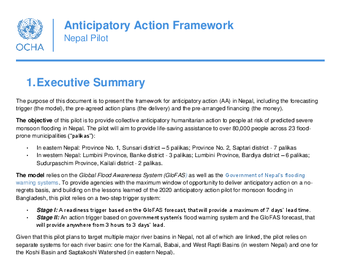Anticipatory Action Framework: Nepal Pilot
The purpose of this document is to present the framework for anticipatory action (AA) in Nepal, including the forecasting trigger (the model), the pre-agreed action plans (the delivery) and the pre-arranged financing (the money).
The objective of this pilot is to provide collective anticipatory humanitarian action to people at risk of predicted severe monsoon flooding in Nepal. The pilot will aim to provide life-saving assistance to over 80,000 people across 23 flood-prone municipalities (“palikas”)
The model relies on the Global Flood Awareness System (GloFAS) as well as the Government of Nepal’s flooding warning systems. To provide agencies with the maximum window of opportunity to deliver anticipatory action on a no-regrets basis, and building on the lessons learned of the 2020 anticipatory action pilot for monsoon flooding in Bangladesh, this pilot relies on a two-step trigger system.
The delivery of anticipatory action is time-critical. Five UN agencies – UNFPA, UNICEF, UN Women, WFP and WHO – in partnership with the Nepal Red Cross Society (NRCS) and national NGOs and in close collaboration with the federal, provincial and local authorities will distribute multi-purpose cash, provide in-kind assistance and deliver services.
The money for the pilot comes from different sources, including from the Central Emergency Response Fund (CERF) of up to $6.7 million. CERF financing will be released as automatically as possible immediately once the defined triggers are reached in each river basin. The pre-arranged financing agreement with CERF is in place for one severe flooding event per river basin over a two-year pilot period from the moment this framework document is pre-endorsed and pre-agreed.


